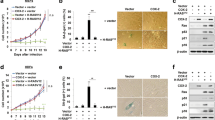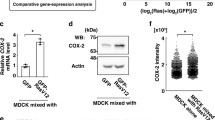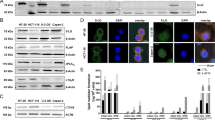Abstract
In this report we describe the contribution of prostaglandin E2 (PGE2) derived from the inducible microsomal PGE-synthase type-1 (mPGES-1) to the epidermal growth factor receptor (EGFR) oncogenic drive in tumor epithelial cells and in tumor-bearing mice. EGFR stimulation upregulated expression of mPGES-1 in HT-29, A431 and A549 cancer cells. Egr-1, a transcription factor induced by EGF, mediated this response. The Egr-1 rise provoked the overexpression of mPGES-1 messenger and protein, and enhanced PGE2 formation. These changes were suppressed either by silencing Egr-1, or by upstream blockade of EGFR or ERK1/2 signals. Further, in a clonogenic assay on tumor cells, EGF induced a florid tumorigenic phenotype, which regressed when mPGES-1 was silenced or knocked down. EGF-induced mPGES-1 overexpression in epithelial cell reduced E-cadherin expression, whereas enhancing that of vimentin, suggesting an incipient mesenchymal phenotype. Additionally, inhibiting the EGFR in mice bearing the A431 tumor, the mPGES-1 expression and the tumor growth, exhibited a parallel decline. In conclusion, these findings provide novel evidence that a tight cooperation between the EGF/EGFR and mPGES-1 leads to a significant tumorigenic gain in epithelial cells, and provide clues for controlling the vicious association.
This is a preview of subscription content, access via your institution
Access options
Subscribe to this journal
Receive 50 print issues and online access
$259.00 per year
only $5.18 per issue
Buy this article
- Purchase on Springer Link
- Instant access to full article PDF
Prices may be subject to local taxes which are calculated during checkout





Similar content being viewed by others
References
Buchanan FG, Wang D, Bargiacchi F, DuBois RN . (2003). Prostaglandin E2 regulates cell migration via the intracellular activation of the epidermal growth factor receptor. J Biol Chem 278: 35451–35457.
Castellone MD, Teramoto H, Williams BO, Druey KM, Gutkind JS . (2005). Prostaglandin E2 promotes colon cancer cell growth through a Gs-axin-beta-catenin signalling axis. Science 310: 1504–1510.
Cheng S, Afif H, Martel-Pelletier J, Pelletier JP, Li X, Farrajota K et al. (2004). Activation of peroxisome proliferator-activated receptor gamma inhibits interleukin-1beta-induced membrane-associated prostaglandin E2 synthase-1 expression in human synovial fibroblasts by interfering with Egr-1. J Biol Chem 279: 22057–22065.
Choe MS, Zhang X, Shin HJ, Shin DM, Chen ZG . (2005). Interaction between epidermal growth factor receptor- and cyclooxygenase 2-mediated pathways and its implications for the chemoprevention of head and neck cancer. Mol Cancer Ther 4: 1448–1455.
Ciardiello F, Tortora G . (2008). EGFR antagonists in cancer treatment. N Engl J Med 358: 1160–1174.
Crosby SD, Puetz JJ, Simburger KS, Fahrner TJ, Milbrandt J . (1991). The early response gene NGFI-C encodes a zinc finger transcriptional activator and is a member of the GCGGGGGCG (GSG) element-binding protein family. Mol Cell Biol 11: 3835–3841.
Dasari A, Messersmith WA . (2010). New strategies in colorectal cancer: biomarkers of response to epidermal growth factor receptor monoclonal antibodies and potential therapeutic targets in phosphoinositide 3-kinase and mitogen-activated protein kinase pathways. Clin Cancer Res 16: 3811–3818.
Deckmann K, Rörsch F, Steri R, Schubert-Zsilavecz M, Geisslinger G, Grösch S . (2010). Dimethylcelecoxib inhibits mPGES-1 promoter activity by influencing EGR1 and NF-κB. Biochem Pharmacol 80: 1365–1372.
Díaz-Muñoz MD, Osma-García IC, Cacheiro-Llaguno C, Fresno M, Iñiguez MA . (2010). Coordinated up-regulation of cyclooxygenase-2 and microsomal prostaglandin E synthase 1 transcription by nuclear factor kappa B and early growth response-1 in macrophages. Cell Signal 22: 1427–1436.
Dohadwala M, Yang SC, Luo J, Sharma S, Batra RK, Huang M et al. (2006). Cyclooxygenase-2-dependent regulation of E-cadherin: prostaglandin E(2) induces transcriptional repressors ZEB1 and snail in non-small cell lung cancer. Cancer Res 66: 5338–5345.
Donnini S, Finetti F, Solito R, Terzuoli E, Sacchetti A, Morbidelli L et al. (2007). EP2 prostanoid receptor promotes squamous cell carcinoma growth through epidermal growth factor receptor transactivation and iNOS and ERK1/2 pathways. FASEB J 21: 2418–2430.
Eberhart CE, Coffey RJ, Radhika A, Giardiello FM, Ferrenbach S, DuBois RN . (1994). Up-regulation of cyclooxygenase 2 gene expression in human colorectal adenomas and adenocarcinomas. Gastroenterology 107: 1183–1188.
Finetti F, Donnini S, Giachetti A, Morbidelli L, Ziche M . (2009). Prostaglandin E(2) primes the angiogenic switch via a synergic interaction with the fibroblast growth factor-2 pathway. Circ Res 105: 657–666.
Golijanin D, Tan JY, Kazior A, Cohen EG, Russo P, Dalbagni G et al. (2004). Cyclooxygenase-2 and microsomal prostaglandin E synthase-1 are overexpressed in squamous cell carcinoma of the penis. Clin Cancer Res 10: 1024–1031.
Grotegut S, von Schweinitz D, Christofori G, Lehembre F . (2006). Hepatocyte growth factor induces cell scattering through MAPK/Egr-1-mediated upregulation of Snail. EMBO J 25: 3534–3545.
Hanaka H, Pawelzik SC, Johnsen JI, Rakonjac M, Terawaki K, Rasmuson A et al. (2009). Microsomal prostaglandin E synthase 1 determines tumor growth in vivo of prostate and lung cancer cells. Proc Natl Acad Science 106: 18757–18762.
Johns TG, Stockert E, Ritter G, Jungbluth AA, Huang HJ, Cavenee WK et al. (2002). Novel monoclonal antibody specific for the de2-7 epidermal growth factor receptor (EGFR) that also recognizes the EGFR expressed in cells containing amplification of the EGFR gene. Int J Cancer 98: 398–408.
Kamei D, Murakami M, Nakatani Y, Ishikawa Y, Ishii T, Kudo I . (2003). Potential role of microsomal prostaglandin E synthase-1 in tumorigenesis. J Biol Chem 278: 19396–19405.
Kamei D, Murakami M, Sasaki Y, Nakatani Y, Majima M, Ishikawa Y et al. (2009). Microsomal prostaglandin E synthase-1 in both cancer cells and hosts contributes to tumor growth, invasion and metastasis. Biochem J 425: 361–371.
Leone V, di Palma A, Ricchi P, Acquaviva F, Giannouli M, Di Prisco AM et al. (2007). PGE2 inhibits apoptosis in human adenocarcinoma Caco-2 cell line through Ras-PI3K association and cAMP-dependent kinase A activation. Am J Physiol Gastrointest Liver Physiol 293: G673–G681.
Lin WW, Karin M . (2007). A cytokine-mediated link between innate immunity, inflammation and cancer. J Clin Invest 117: 1175–1183.
Lu D, Han C, Wu T . (2012). Microsomal prostaglandin E synthase-1 promotes hepatocarcinogenesis through activation of a novel EGR1/β-catenin signalling axis. Oncogene 31: 842–857.
Mann JR, Backlund MG, Buchanan FG, Daikoku T, Holla VR, Rosenberg DW et al. (2006). Repression of prostaglandin dehydrogenase by epidermal growth factor and snail increases prostaglandin E2 and promotes cancer progression. Cancer Res 66: 6649–6656.
Menter DG, Schilsky RL, DuBois RN . (2010). Cyclooxygenase-2 and cancer treatment: understanding the risk should be worth the reward. Clin Cancer Res 16: 1384–1390.
Nah SS, Won HJ, Ha E, Kang I, Cho HY, Hur SJ et al. (2010). Epidermal growth factor increases prostaglandin E2 production via ERK17sol;2 MAPK and NF-kappaB pathway in fibroblast like synoviocytes from patients with rheumatoid arthritis. Rheumatol Int 30: 443–449.
Nakanishi M, Montrose DC, Clark P, Nambiar PR, Belinsky GS, Claffey KP et al. (2008). Genetic deletion of mPGES-1 suppresses intestinal tumorigenesis. Cancer Res 68: 3251–3259.
Naraba H, Yokoyama C, Tago N, Murakami M, Kudo I, Fueki M et al. (2002). Transcriptional regulation of the membrane-associated prostaglandin E2 synthase gene Essential role of the transcription factor Egr-1. J Biol Chem 277: 28601–28608.
Pai R, Soreghan B, Szabo IL, Pavelka M, Baatar D, Tarnawski AS . (2002). Prostaglandin E2 transactivates EGF receptor: a novel mechanism for promoting colon cancer growth and gastrointestinal hypertrophy. Nat Med 8: 289–293.
Pignatelli M, Cortes-Canteli M, Santos A, Perez-Castillo A . (1999). Involvement of the NGFI-A gene in the differentiation of neuroblastoma cells. FEBS Lett 461: 37–42.
Pozzi A, Yan X, Macias-Perez I, Wei S, Hata AN, Breyer RM et al. (2004). Colon carcinoma cell growth is associated with prostaglandin E2/EP4 receptor-evoked ERK activation. J Biol Chem 279: 29797–29804.
Samuelsson B, Morgenstern R, Jakobsson PJ . (2007). Membrane prostaglandin E synthase-1: a novel therapeutic target. Pharmacol Rev 59: 207–224.
Subbaramaiah K, Yoshimatsu K, Scherl E, Das KM, Glazier KD, Golijanin D et al. (2004). Microsomal prostaglandin E synthase-1 is overexpressed in inflammatory bowel disease Evidence for involvement of the transcription factor Egr-1. J Biol Chem 279: 12647–12658.
Tessner TG, Muhale F, Riehl TE, Anant S, Stenson WF . (2004). Prostaglandin E2 reduces radiation-induced epithelial apoptosis through a mechanism involving AKT activation and bax translocation. J Clin Invest 114: 1676–1685.
Thiery JP, Acloque H, Huang RY, Nieto MA . (2009). Epithelial-mesenchymal transitions in development and disease. Cell 139: 871–890.
Wang D, Dubois RN . (2010). Eicosanoids and cancer. Nat Rev Cancer 10: 181–193.
Wiesner GL, Platzer P, Buxbaum S, Lewis S, MacMillen M, Olechnowicz J et al. (2001). Testing for colon neoplasia susceptibility variants at the human COX2 locus. J Natl Cancer Inst 93: 635–639.
Yoshimatsu K, Altorki NK, Golijanin D, Zhang F, Jakobsson PJ, Dannenberg AJ et al. (2001a). Inducible prostaglandin E synthase is overexpressed in non-small cell lung cancer. Clin Cancer Res 7: 2669–2674.
Yoshimatsu K, Golijanin D, Paty PB, Soslow RA, Jakobsson PJ, DeLellis RA et al. (2001b). Inducible microsomal prostaglandin E synthase is overexpressed in colorectal adenomas and cancer. Clin Cancer Res 7: 3971–3976.
Acknowledgements
We thank Dr MD Díaz-Muñoz for the construction of mPGES-1 plasmids. This work has received financial support from the Associazione Italiana della Ricerca sul Cancro (AIRC) IG10731 (MZ), Istituto Toscano Tumori (ITT) (SD), Comunidad de Madrid S-SAL2006/0015, Ministerio de Ciencia e Innovación SAF2010-18733 (MF), Ministerio de Ciencia e Innovación BFU2010-21055 (MAI).
Author information
Authors and Affiliations
Corresponding author
Ethics declarations
Competing interests
The authors declare no conflict of interest.
Rights and permissions
About this article
Cite this article
Donnini, S., Finetti, F., Terzuoli, E. et al. EGFR signaling upregulates expression of microsomal prostaglandin E synthase-1 in cancer cells leading to enhanced tumorigenicity. Oncogene 31, 3457–3466 (2012). https://doi.org/10.1038/onc.2011.503
Received:
Revised:
Accepted:
Published:
Issue Date:
DOI: https://doi.org/10.1038/onc.2011.503
Keywords
This article is cited by
-
Inhibition of EGR1 inhibits glioma proliferation by targeting CCND1 promoter
Journal of Experimental & Clinical Cancer Research (2017)



